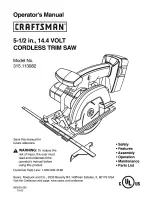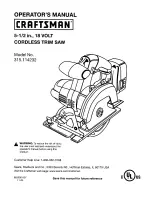
21
is released in the atmosphere. WIPE wood
dust away (do not blow away with pressured
air), repair leaks in the tubes and ensure
appropriate ventilation.
Do not use saw blades which are damaged
or deformed.
Always clamp or press the workpiece
firmly against the saw guide, before you carry
out the process.
Do not modify the machine; unauthorised
parts have not been tested and approved.
Mainly use:
• No unauthorised saw blades
• No unauthorised safety systems 7
• Always use the supplied safety systems!
• Always use a cavity blade for scalloping.
4.46 Wear ear protectors. The following
facors can be of influence in producing noise:
• The kind of material to be cut
• The sawblade
• The force of which the workpiece is fed
Loud noise can lead to hearing damage.
Ensure that you wear ear protectors. Ensure
that the cavity blade is not bent, this can also
cause noise.
4.47 Residual risks
The following risks are inherent to the use
of these machines:
• Injuries caused by touching the rotating
parts
• Injuries caused by disruption of the
cutting blade
These risks are most evident:
• Within the range of operation
• Within the range of the rotating machine
parts In spite of the application of the relevant
safetyregulations and the implementation of
safety devices, certain residual risks cannot
be avoided. These are:
• Impairment of hearing.
• Risk of accidents caused by the
uncovered parts of the rotating cutting
blade.
• Risk of injury when changing the blade.
• Risk of squeezing fingers when opening
the guards.
5. TRANSPORT
Before all work on the machine, pull the
mains plug.
Check that all locks and tensioning devices
are secure:
• Turn the locking knob on the turntable
counterclockwise
• Slide the machine completely towards
yourself
• Turn the locking knob on the turntable
clockwise to lock the slide-function
• Unlock the pin on the right hand side of
the machine
• Push the button in the handgrip to unlock
the saw blade protection
• Push the machine completely downwards
• Lock the pin on the right hand side again
Only lift the machine by the solid underside
of the machine.
While the machine is in use
With frequent use of the machine, do not
let routine lead to mistakes. Remember that
a slight lack of concentration can lead to
serious injuries in a fraction of a second.
• Before beginning to saw, make sure that
the protective hood is in the right position.
• Before cutting the first cut, let the
machine run for a short while. If you hear
any unusual sounds or observe any strong
vibration, turn the machine off and take the
plug out of the socket, and then find the cause
of the problem. Do not switch the machine on
again until the cause has been found and the
fault repaired.
• Make sure that the piece of work being
sawn off does not get stuck in place, do not
hold it or clamp it and no not secure it against
the stop.
It must be able to move freely along
the side of the saw blade. When this is not
possible the piece of work being sawn can be
trapped by the saw blade and be flung about.
• Avoid placing your hands anywhere
where in the case of a sudden movement one
or both hands can come into contact with the
saw blade.
• Let the saw get up to full revolutions
before you start sawing.
• Press the saw head downwards so that
the motor is not overloaded and the saw
blade does not get jammed.
• If you need to remove jammed material,
first let the saw blade stop turning completely,
switch the motor off and take the plug out of
the socket.
• At the end of the sawing process, keep
the saw head downwards, switch off the
machine and wait until all moving parts has
come to a stop before you take your hands off
















































